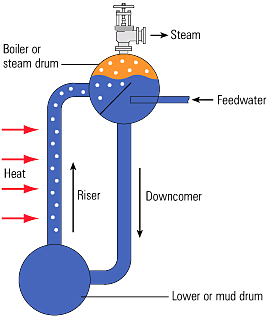The design of Water Tube Boilers is strictly opposite to that of Fire Tube Boilers design. In water tube boiler systems, the water to be
heated is enclosed inside the boiler tubes whereas the hot combustion
gases exhausted by the burner keep circulating around the tube surfaces.
The water within the tubes then gets heated via the hot flue gases and
finally converted into steam. The diameter of the boiler tubes is kept
very small in these boiler systems to provide them the capability to withstand higher pressures for the equivalent amount of stress. Water
tube boiler designs are particularly suitable for high steam output
requirements. Hence, their use is mainly preferred in industries for
various types of process applications over home heating systems.
Operating Principle
Natural water circulation, also referred to as “thermo-siphoning” is the major working principle for almost all water-tube boilers. This principle is illustrated via the diagram shown below.
Operating Principle
Natural water circulation, also referred to as “thermo-siphoning” is the major working principle for almost all water-tube boilers. This principle is illustrated via the diagram shown below.
 |
Cooler feedwater is introduced into the steam drum behind a baffle where, because the density of the cold water is greater, it descends in the 'downcomer' towards the lower or 'mud' drum, displacing the warmer water up into the front tubes. Due to continuous heating, steam bubbles gets created in the front side of boiler tubes. In the boiler drum, these bubbles get automatically separated from the heated water and finally carried out.
As soon as the pressure rises inside the boiler, the deviation between the water density and saturated steam density tends to reduce resulting in less circulation. To keep the same level of steam output at higher design pressures, the distance between the lower drum and the steam drum must be increased, or some means of forced circulation must be introduced.
No comments:
Post a Comment